Irene on the Eastern Seaboard of North America
Dear Reader,
We have neglected you. We’re sorry. We had good intentions but were thwarted by laziness, exhaustion, and writer’s block. We will do better in the future.

When we last wrote, back in April of 2018, we wrote of being fresh out of the Arctic (which had actually happened in September 2017) and we were looking forward to:
1) Getting warm again.
2) Getting some help with replacing three broken motor mounts.
3) Getting to a suitable winter spot, far enough south to get some work done on the boat over the winter.
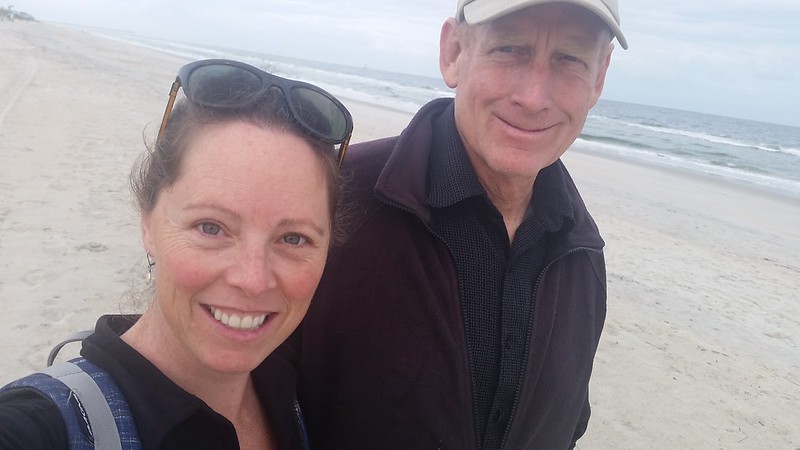
All of that did happen – and more, of course – while Irene first travelled SW down the Eastern Seaboard all the way to Miami and beyond then back NE all the way to Nova Scotia, and finally finished the cruising season with an Eastbound crossing of the North Atlantic to Ireland in August. Here are our impressions of that time:

Southbound
Irene arrived in Maine October of 2017 needing help. We were limping under power with three broken motor mounts on our trusty Isuzu. The first mount had broken in a wild night powering north in a nasty chop near the north end of Prince William Island in the arctic and the second and third failing in the Labrador Sea. Until these were replaced we were limited to low RPMs and calm water motoring only. Maine seemed like it might be a good place to get this work done, but our first stop at Rockland fizzled. Although the marina had promised to do the work quickly they kept delaying. Eventually, it became clear that it might not happen in time for us at all, and so we moved on to Portland.

As happens in the cruising world, with the help of sailors (Rob and Natalie on Wilhelm) we had met in Africa years ago, Irene was taken care at Spring Point Marina by Casco Bay Diesel. Morale onboard improved a bit.
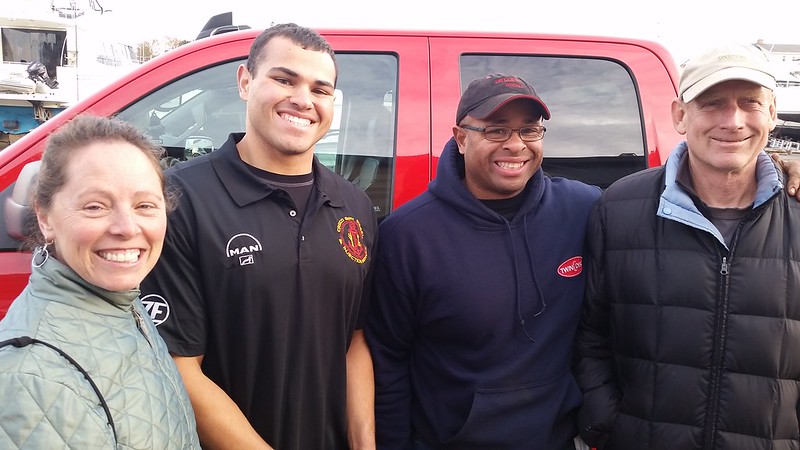
November was half gone and we were eager to get down to warmer latitudes, so we hopped nonstop down to the Chesapeake Bay – which we approached in darkness and wave conditions that had Irene staggering. We took a few waves on deck – more about that in a minute – as we made our way up towards Norfolk, VA through a maze of lights and buoys. Getting closer to our planned anchorage the wind became shifty and gusty, so we fired up the motor and furled sails, and concentrated on the complex piloting required to get in to the anchorage. Just then, at that moment, the motor started dropping rpm’s in that distinctive “my fuel filter is clogged!” way. Some water from one of those Chesapeake Bay waves must have found it’s way into our tank. We unfurled the jib and Peter sprinted down to the engine room to quickly change the filter, inhaling diesel fumes, dead tired, fighting seasickness, Ginger watching the commercial traffic and the rapidly approaching shoreline – and we thought to ourselves “exactly WHAT about this is fun???” All in a night’s work but... morale took a downturn.
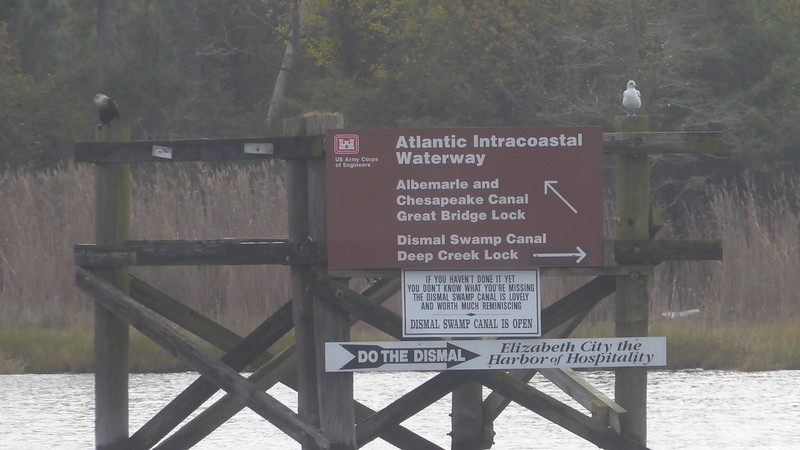
Of course, after a good night’s sleep at anchor, and then a few warm calm days motoring down the Intracoastal Waterway and a few blissful long calm nights on the hook or tied up to a bulkhead, things were definitely looking up. The ICW was wonderful for us. There wasn’t much traffic. Our tired eyes took in the scenery, all green and beautiful. We saw so many trees! And reeds, and herons, egrets and bears. The birds sang and the water was flat and gentle. Things that seem to bother other ICW travelers did not bother us a bit – rather than annoying us as a delay, the draw bridges broke up the routine and gave us cheery little radio conversations with bridge operators. “Captain, y’all enjoy the day!” We bumped once or twice on some of the muddy shallow spots, but Irene barely hesitated at all and kept on going. Some thin water spots we looked aft and our wake was more mud than water, but Irene kept on going. The wind was mostly light, but we were able to sail some long stretches. Some of these stretches were long straight channels where the autopilot did most of the work, but some more serpentine sections gave us a workout jibing, steering, and jibing again. All fun, and morale aboard Irene was steadily climbing.
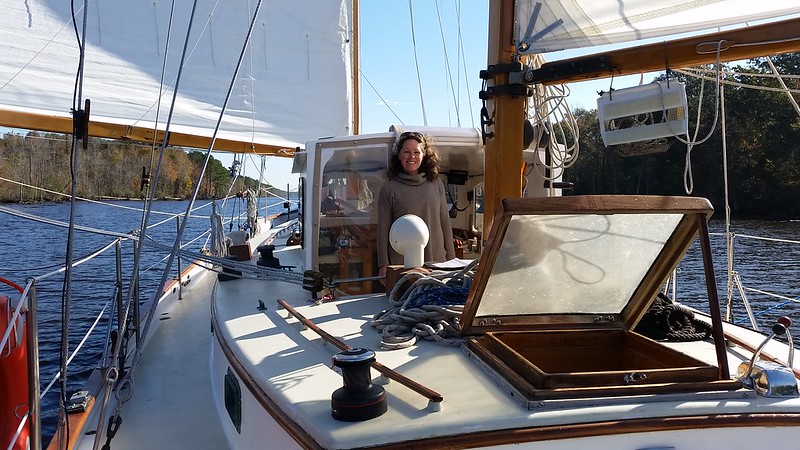
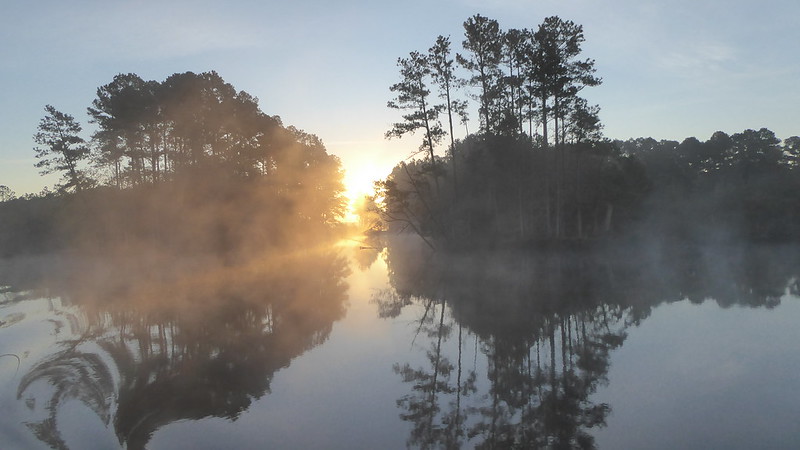
Our chosen spot for the winter was Lady’s Island Marina in Beaufort, SC. Pronounced Beew-fort, not Bo–fort like admiral or the town in North Carolina.
We chose the spot for:
1) Far enough south for warmer and longer days
2) Boat would be within walking distance to grocery and hardware stores
3) A covered area was said to be available for light boat maintenance shop projects
We arrived on the 27th of November, quickly verified that all three items were true, and tied up for the winter.
It wasn’t long before we also discovered:
1) Within walking distance were an excellent bakery, a very good ice cream store, a wonderful yoga studio, a swimming pool, and a sail repair shop.
2) The marina was staffed and inhabited by a wonderful and unusual group of friendly talented people.
3) The “low country” (as this region is called) is stunningly beautiful – long red sunsets and sunrises, dolphins with their young ones hunting between the boats, egrets and buzzards, frogs and lizards.
So Irene enjoyed possibly the most comfortable and beautiful off season we’ve ever had.
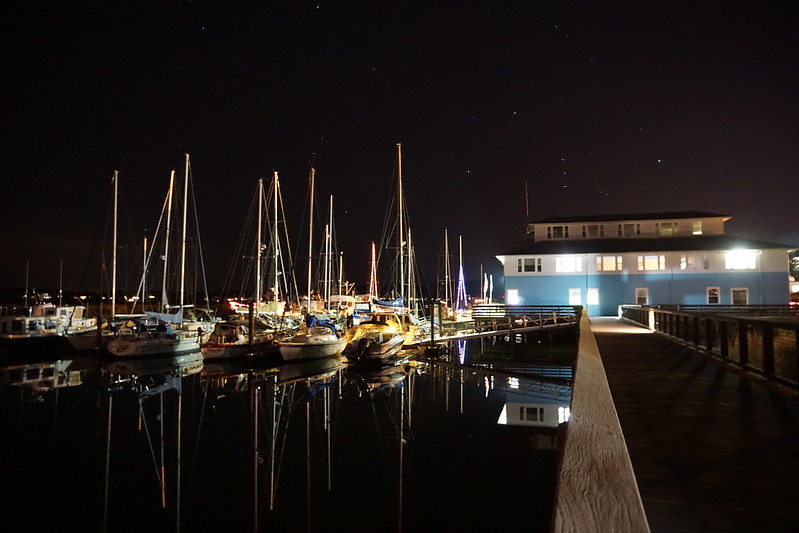
In April 2018, with repairs done, Irene set sail for Florida. We chose to head out to sea rather than the “ditch” as the ICW is called, because we were missing open water and wanted to get down to Miami as quickly as possible. The passage was routine except the afternoon we needed to duck into Ft Lauderdale to wait out a night of contrary winds. These winds arrived a few hours early, just as we were inside the channel waiting for a bridge to open. We had a wild hour first dodging a departing cruise ship and police escort in torrential rain and then winding up a channel to a tiny anchorage. We learned later that we were literally in a tornado for a time, but it all worked out for us.
After two failed attempts to find safe and legal spot to anchor we found an anchorage right downtown near South Beach in Miami. The people watching and boat watching was good, but the edgy urban vibes weren’t pleasant. The security at the hotels glared at us as we rowed by in the dinghy and access wasn’t allowed after dark to the few allotted dinghy tie up spots. A fact that we discovered after dark of course! On the plus side, the restaurants were good and plentiful and we really enjoyed the Latin flavor in the neighborhoods.
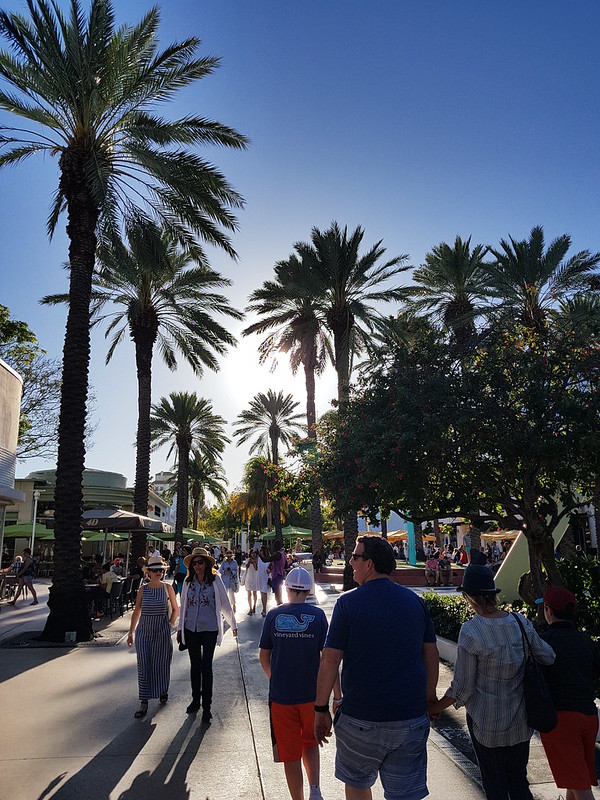
Northbound Again
The sun and fun of South Beach didn’t hold Irene’s interest for long, so we headed north, aiming to explore in detail parts of the coast that we had missed on the way down. We elected to sail offshore rather than take the ditch – ready to make the good mileages possible on passage rather that poking along in shore, however pleasant the ICW may be. Hailing from the west coast, it was interesting to finally (after years of reading about it) cruise the east coast.
Here are some of our notes:
The Gulf Stream
After clearing the breakwater at Government Cut in Miami, Irene turned to port and headed north downwind and downstream in the great river of warm water that is the Gulf Stream. We had avoided the stream on the southbound trip because it was heading the wrong way and would have slowed us down, but now there was every reason to ride the current north. The day was truly delightful with our ketch charging along with all sail set in blazing sun and sparkling waves. Small shoals of flying fish launched out of these waves periodically and the chartplotter showed that we were logging ten or twelve glorious knots.
We spotted a classic looking yawl or ketch in the distance that looked like it was heading the same way and as we converged we chatted on VHF radio. Their home port was in Denmark and we enjoyed the company (somebody to race!) as the afternoon wore on.
The VHF started squawking with regular thunderstorm alerts – a horrible jarring tone that we still haven’t found a volume adjustment for – and the white fluffy clouds around us began to develop ominous dark tops. Well, it looked like a squally afternoon might be developing and we’ve been in lots of tropical squalls over the years, so were weren’t really concerned as we made our plans. Although we considered reducing sail, to do so seemed extreme considering the lovely wind and small waves and the fact that we seemed to be gaining on our Danish friends. So, we kept an eye to windward and configured the radar to look for squalls.
The afternoon grew dark as towering clouds obscured the sun but the radar told us that nothing serious was developing. Until… the radar screen suddenly turned bright yellow (rain and wind!) and an evil white line appeared on the horizon. Squall! We jumped to the halyards and sheets, dropping the main first. The wind hit like a hammer just as the main was safely down in the lazy jacks. Ginger put a single tie on the main as Peter braced himself knee deep in warm gulf stream water on the lee side deck and struggled to roll up the yankee jib. As the last wrap was rolled in Irene found a new record extreme angle of heel and the decks seemed almost vertical. We leapt back to the mizzen, the only sail left set, and together clawed it down inch by inch. The sky was pitch black now, and thunder crashed and lightning flashed every few seconds. That job done, we met back in the doghouse to regroup with Irene running across the stream on a broad reach under bare poles, rail under, at about twelve knots. Wow!
We turned our concern to navigation – a quick check showed we had a few miles of sea room on the current course, safe enough for now - and tried to see if we could figure out where the Danish boat might be. Radar wasn’t useable in the heavy rain, visibility wasn’t good, and we imagined they might be close. Sure enough, a grey shape appeared out of the gloom aft of us, luckily not on a collision course at all. They spotted us too and we learned over the radio that their main boom had been broken in the blast and they were diverting to the nearest port to sort things out.
Later that night, motoring in windless slop after enduring yet another thunderstorm, we decided that Gulf Stream life was not for us and we altered course to complete our passage inshore of the stream. At that point we figured even if the daily mileage wasn’t as good life would be more pleasant. Before dawn we were sailing in light but steady conditions and watching beautiful storms to our starboard, one after another in a line a hundred miles long, each silently flickering with lightning looking like some sort of apocalyptic battle playing out in the distance.
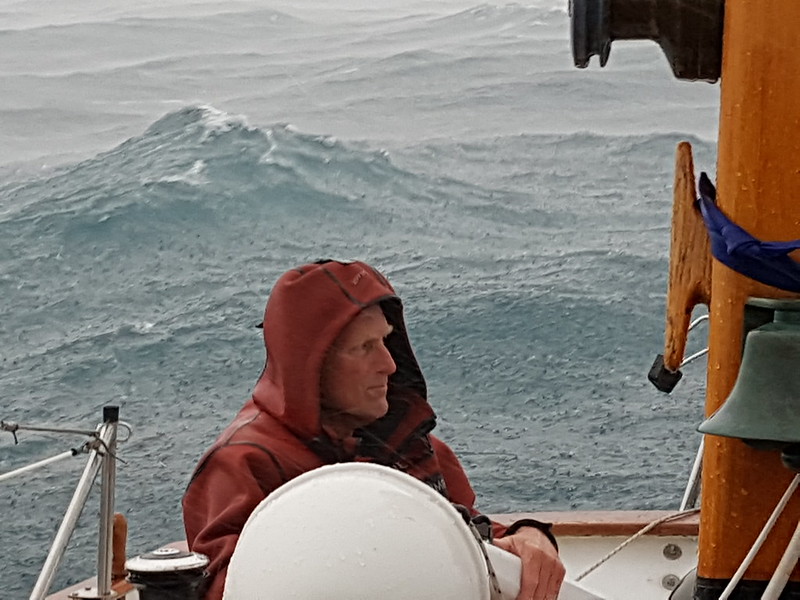
The Chesapeake
We did sail back into the stream again for half a day as we rounded Cape Hatteras in overcast and steady conditions and enjoyed another speed boost but this time without the drama. Our long approach to the Chesapeake was uneventful and we experienced conditions pleasant enough once in the Bay proper to continue sailing all night rather than anchoring. The next day at about the halfway point up the bay we dropped the hook at a pleasant spot on the western shore, our home base for exploring for a week or two.
1) Sail rules! In contrast to our home waters on the West Coast we saw more sailboats than power, few sailboats motoring and sails everywhere.
2) Anchoring does not get easier! Nice sticky mud is rarely deeper than a few feet below the keel in any of the hundreds of coves and inlets. Here, why bother with a chain rode and windlass, rope works just fine.
3) Traditional sail! Skiffs and skipjacks, bugeyes and log canoes, and even schooners and sandbaggers, Peter was in heaven.
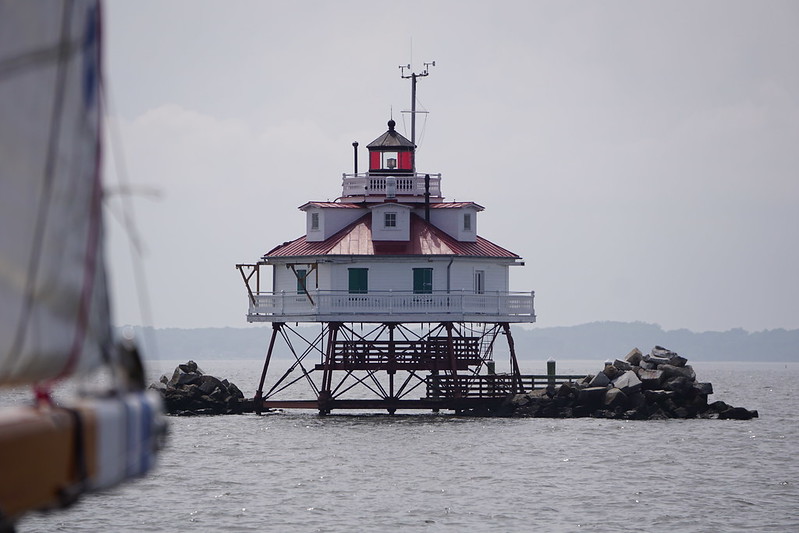
Delaware Bay
We took Irene through a canal connecting the Chesapeake with Delaware Bay and motored the length of that bay out to sea again. We passed a nuclear power plant as we powered directly into the chop sea breeze. Dead fish floated everywhere in filthy brown water. Not scenic, though to be fair the marshes on the Jersey side are said to have some good anchorages. Destinations further north called us though, and we hurried on. Once at sea, we set all plain sail and the spinnaker for a wonderful fast reach north, bound for Sandy Hook and New York City!
New York and Long Island Sound


All those little states - Rhode Island, Connecticut, Massachusetts
Sails everywhere! So much history! Good sailing! Toney yacht clubs! So many xx!@#$% moorings clogging many protected anchoring spots!
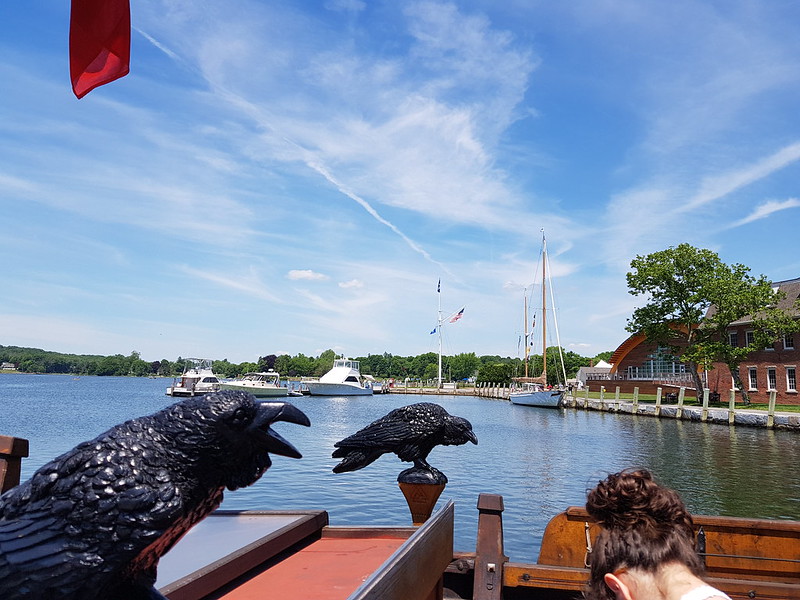
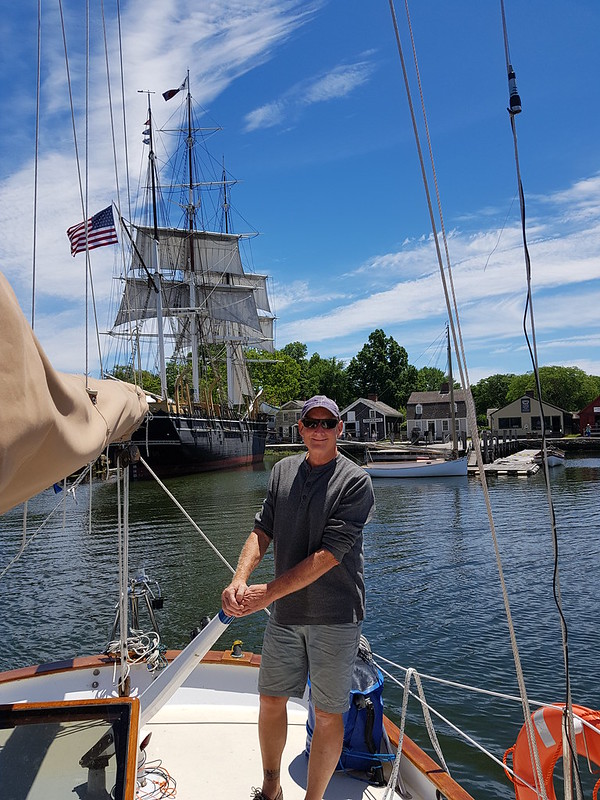
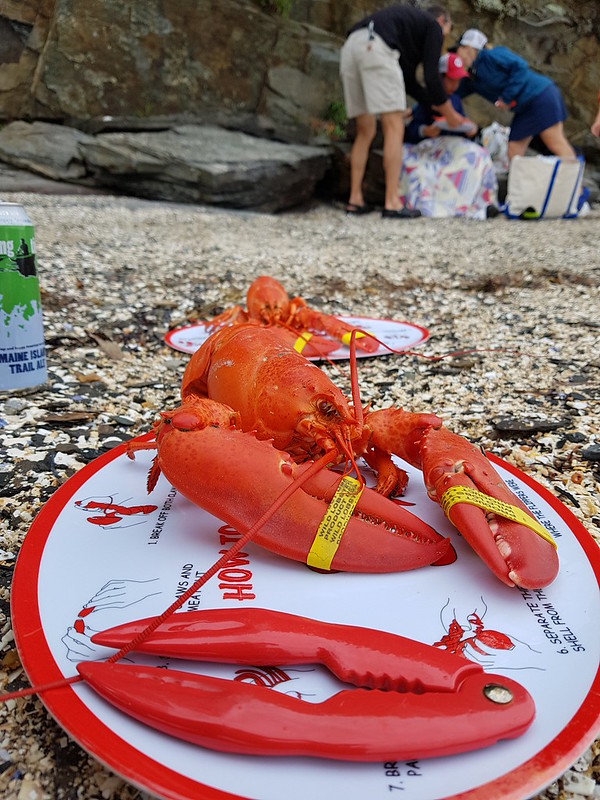
Back to Maine
From our time the previous year we knew something of Maine. Awesome scenery, but way too many lobster pot buoys, to be specific. Our strategy? Travel under power at night or in heavy fog is absolutely forbidden to us because we would certainly foul a pot at some point. So we simply sailed on with no attempt to maneuver around them. We’d hear the buoys scrape alongside at times, and just shrug. Irene’s long keel was a great asset in the state of Maine.
The sailing conditions were good and we enjoyed our time there as we knew we would. On our way out of the US to head across the Bay of Fundy to Nova Scotia we were unable to fill our water tanks at the local fuel dock as we had planned. Drought conditions and no water available!
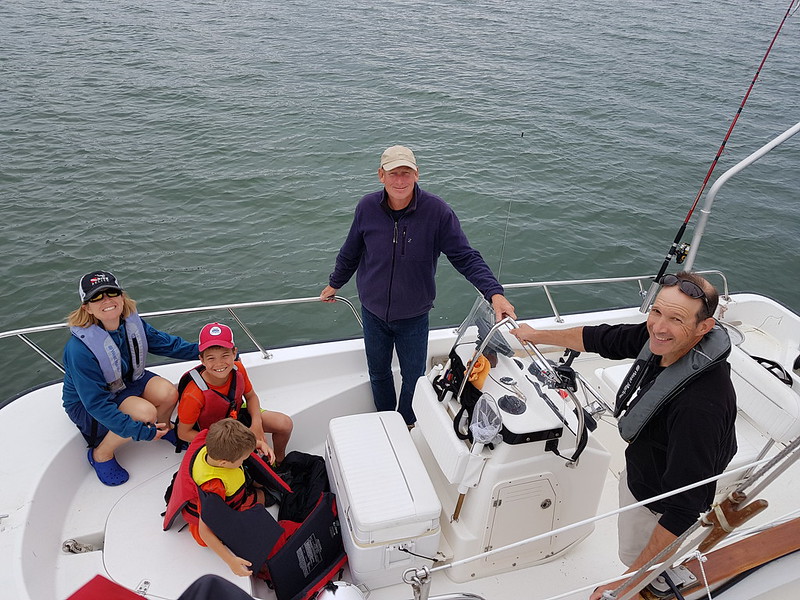
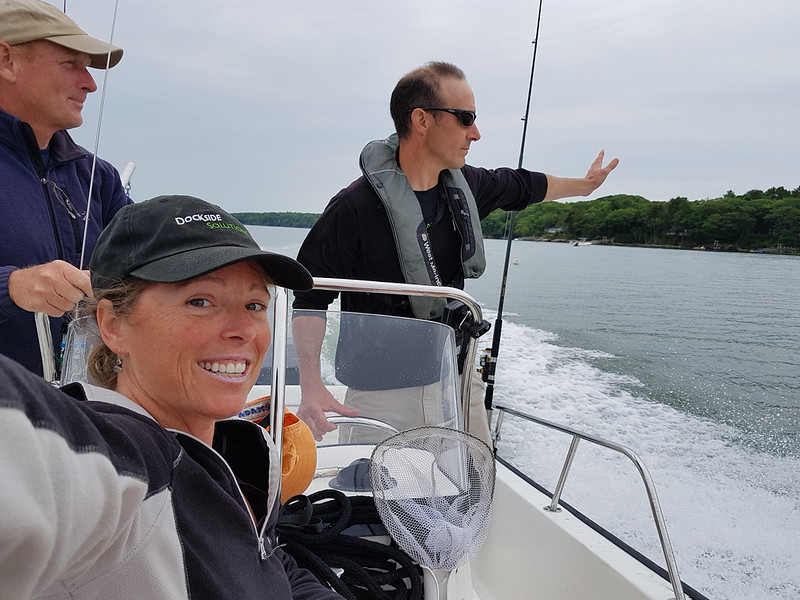
Nova Scotia
Irene made a good fast crossing to Lunenburg despite (or because of!) her light condition of empty water tanks and low fuel. As we left the pressures of the crowded coast of our own country in our wake we took some deep grateful breaths of clean Canadian air. Lunenburg has a wonderful big anchorage, blissfully free of lobster pot buoys, and it was full of a mixture of anchored cruising boats and classic craft. We felt relaxed and happy and no one seemed upset at all that Irene was anchored in their bay. In fact, dories rowed along the shore and gaff rigged boats tacked and jibed around us calling out their greetings. We rowed ashore, explored, saw the fisheries museum (wonderful models,) and walked historic streets and paths. We were able to pull alongside a wharf to fill up with water, though fuel wasn't available here.
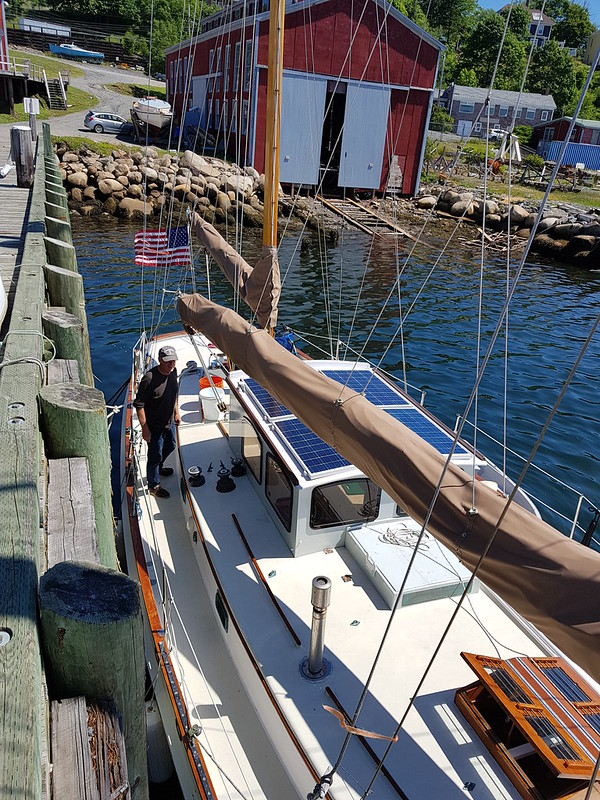
Fortunately, favorable wind and sailing conditions made us unconcerned about our lack of fuel. After thoroughly exploring the town we headed back to sea. Our destination was a body of mostly fresh water near the north end of the province, Bras d’Or. After an easy locking through (with almost no elevation change) we entered a tide-less warm inland sea.
Bras d’Or
1) Perfect sailing conditions – steady warm wind with small waves.
2) Almost perfect swimming conditions – maybe a few too many jelly fish.
3) Birthplace of Cruising Club of America – Maskell’s Harbor. A pilgrimage anchorage for Irene.
4) Perfect little bays and harbors to spend the night, or a week or two.
Irene and crew might still be there but for our intimate knowledge of how hard winter hits this part of the world. So we fueled up and took advantage of the warm water to scrub Irene’s bottom. We wanted her nice and clean to speed our long passage across the North Atlantic to Ireland.
In conclusion, a left coast sailor’s comparison of the other side:
What a wonderful natural sailor’s playground the eastern seaboard is, from Maine to Florida. This coast has a huge complex coastline chock full of sheltered bays and anchorages to explore and the wind and weather to do so easily under sail almost every inch of the way. Plus history, traditional craft, and museums everywhere. On the other hand, this coast is downright unfriendly to the sailing traveler in many ways. The wonderful harbors are often choked with private moorings, the shores lined with private property, and the atmosphere is one of don’ts – don’t anchor here, don’t try to put ashore here in your dinghy, no, no, no, private, private, private! To be fair, we haven’t yet mentioned in our story that we met up on many occasions with friends new and old, and relatives close and distant, and even made new friends during our cruise. These people made all the difference paving our way, making introductions, pointing out the good places, and opening doors to mooring buoys, anchorages, introductions and even a place to tie up on occasion. So maybe this is just how it’s supposed to work on this coast - it’s not about how you go, it’s about who you know!
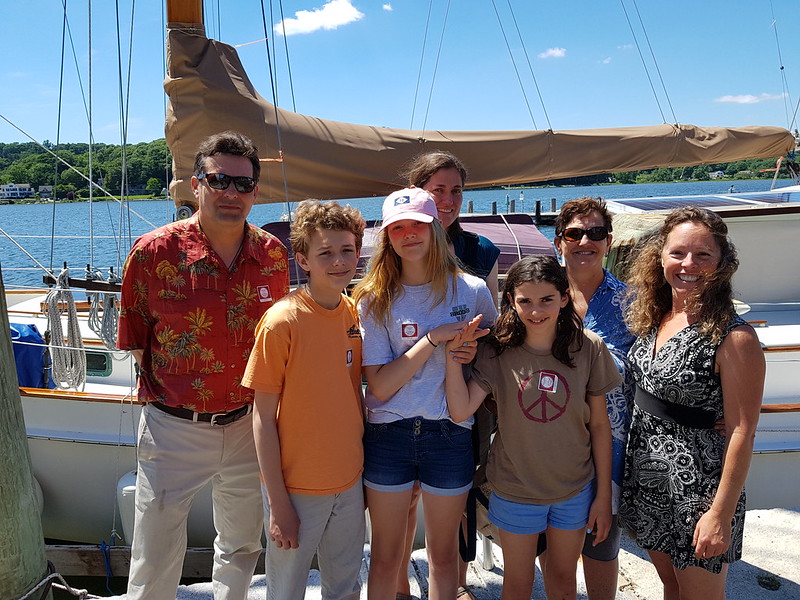
A partial list of these important friends and relatives:
1) Debrae Bishop, Maine (first met in the South Pacific 2007)
2) Eric Hopkins, Maine (a "cousin with a K", artist and Rockland native)
3) Robert and Natalie of Wilhelm, Maine (first met in Africa in 2008)
4) Sophie and Didier of Sauvage, Florida (first met in Alaska 2015)
5) Jeff and Gail of Lazy Bones, Florida (first met in the South Pacific 2007)
6) Rachel, Florida (childhood friend)
7) Tom and Prue and family, Maryland (relatives, sailors, and encyclopedic knowledge of all things and places nautical on the coast)
8) The large and connected Palmer family, New York and Connecticut (relatives, sailors and encyclopedic knowledge of all things historical and current in NYC and Stonington)
9) Mystic Seaport, Connecticut (welcoming and fascinating sail history museum complex)
10) Wendy, and the SSCA Gam, Essex (visiting club friend and friendly club reception)
11) Mike Dee, Warren, RI (sailor friend from North Carolina 2017 introduced us to the town)
12) Nick and Cindi, Maine (sailors from Seattle met 2005 sailed with them to Mexico in 2006, now resident in Maine)
13) The Tremblay family – met in Halifax Oct 2017 and a reunion in Bras d’Or lake
And so, thank you, dear reader, for your patience for this long post. You’re now almost up to real time in Irene’s story. Coming soon, a north Atlantic crossing and Irene settles in for the winter in Scotland.
We have neglected you. We’re sorry. We had good intentions but were thwarted by laziness, exhaustion, and writer’s block. We will do better in the future.

When we last wrote, back in April of 2018, we wrote of being fresh out of the Arctic (which had actually happened in September 2017) and we were looking forward to:
1) Getting warm again.
2) Getting some help with replacing three broken motor mounts.
3) Getting to a suitable winter spot, far enough south to get some work done on the boat over the winter.

All of that did happen – and more, of course – while Irene first travelled SW down the Eastern Seaboard all the way to Miami and beyond then back NE all the way to Nova Scotia, and finally finished the cruising season with an Eastbound crossing of the North Atlantic to Ireland in August. Here are our impressions of that time:

Southbound
Irene arrived in Maine October of 2017 needing help. We were limping under power with three broken motor mounts on our trusty Isuzu. The first mount had broken in a wild night powering north in a nasty chop near the north end of Prince William Island in the arctic and the second and third failing in the Labrador Sea. Until these were replaced we were limited to low RPMs and calm water motoring only. Maine seemed like it might be a good place to get this work done, but our first stop at Rockland fizzled. Although the marina had promised to do the work quickly they kept delaying. Eventually, it became clear that it might not happen in time for us at all, and so we moved on to Portland.

As happens in the cruising world, with the help of sailors (Rob and Natalie on Wilhelm) we had met in Africa years ago, Irene was taken care at Spring Point Marina by Casco Bay Diesel. Morale onboard improved a bit.

November was half gone and we were eager to get down to warmer latitudes, so we hopped nonstop down to the Chesapeake Bay – which we approached in darkness and wave conditions that had Irene staggering. We took a few waves on deck – more about that in a minute – as we made our way up towards Norfolk, VA through a maze of lights and buoys. Getting closer to our planned anchorage the wind became shifty and gusty, so we fired up the motor and furled sails, and concentrated on the complex piloting required to get in to the anchorage. Just then, at that moment, the motor started dropping rpm’s in that distinctive “my fuel filter is clogged!” way. Some water from one of those Chesapeake Bay waves must have found it’s way into our tank. We unfurled the jib and Peter sprinted down to the engine room to quickly change the filter, inhaling diesel fumes, dead tired, fighting seasickness, Ginger watching the commercial traffic and the rapidly approaching shoreline – and we thought to ourselves “exactly WHAT about this is fun???” All in a night’s work but... morale took a downturn.

Of course, after a good night’s sleep at anchor, and then a few warm calm days motoring down the Intracoastal Waterway and a few blissful long calm nights on the hook or tied up to a bulkhead, things were definitely looking up. The ICW was wonderful for us. There wasn’t much traffic. Our tired eyes took in the scenery, all green and beautiful. We saw so many trees! And reeds, and herons, egrets and bears. The birds sang and the water was flat and gentle. Things that seem to bother other ICW travelers did not bother us a bit – rather than annoying us as a delay, the draw bridges broke up the routine and gave us cheery little radio conversations with bridge operators. “Captain, y’all enjoy the day!” We bumped once or twice on some of the muddy shallow spots, but Irene barely hesitated at all and kept on going. Some thin water spots we looked aft and our wake was more mud than water, but Irene kept on going. The wind was mostly light, but we were able to sail some long stretches. Some of these stretches were long straight channels where the autopilot did most of the work, but some more serpentine sections gave us a workout jibing, steering, and jibing again. All fun, and morale aboard Irene was steadily climbing.


Our chosen spot for the winter was Lady’s Island Marina in Beaufort, SC. Pronounced Beew-fort, not Bo–fort like admiral or the town in North Carolina.
We chose the spot for:
1) Far enough south for warmer and longer days
2) Boat would be within walking distance to grocery and hardware stores
3) A covered area was said to be available for light boat maintenance shop projects
We arrived on the 27th of November, quickly verified that all three items were true, and tied up for the winter.
It wasn’t long before we also discovered:
1) Within walking distance were an excellent bakery, a very good ice cream store, a wonderful yoga studio, a swimming pool, and a sail repair shop.
2) The marina was staffed and inhabited by a wonderful and unusual group of friendly talented people.
3) The “low country” (as this region is called) is stunningly beautiful – long red sunsets and sunrises, dolphins with their young ones hunting between the boats, egrets and buzzards, frogs and lizards.
So Irene enjoyed possibly the most comfortable and beautiful off season we’ve ever had.

In April 2018, with repairs done, Irene set sail for Florida. We chose to head out to sea rather than the “ditch” as the ICW is called, because we were missing open water and wanted to get down to Miami as quickly as possible. The passage was routine except the afternoon we needed to duck into Ft Lauderdale to wait out a night of contrary winds. These winds arrived a few hours early, just as we were inside the channel waiting for a bridge to open. We had a wild hour first dodging a departing cruise ship and police escort in torrential rain and then winding up a channel to a tiny anchorage. We learned later that we were literally in a tornado for a time, but it all worked out for us.
After two failed attempts to find safe and legal spot to anchor we found an anchorage right downtown near South Beach in Miami. The people watching and boat watching was good, but the edgy urban vibes weren’t pleasant. The security at the hotels glared at us as we rowed by in the dinghy and access wasn’t allowed after dark to the few allotted dinghy tie up spots. A fact that we discovered after dark of course! On the plus side, the restaurants were good and plentiful and we really enjoyed the Latin flavor in the neighborhoods.

Northbound Again
The sun and fun of South Beach didn’t hold Irene’s interest for long, so we headed north, aiming to explore in detail parts of the coast that we had missed on the way down. We elected to sail offshore rather than take the ditch – ready to make the good mileages possible on passage rather that poking along in shore, however pleasant the ICW may be. Hailing from the west coast, it was interesting to finally (after years of reading about it) cruise the east coast.
Here are some of our notes:
The Gulf Stream
After clearing the breakwater at Government Cut in Miami, Irene turned to port and headed north downwind and downstream in the great river of warm water that is the Gulf Stream. We had avoided the stream on the southbound trip because it was heading the wrong way and would have slowed us down, but now there was every reason to ride the current north. The day was truly delightful with our ketch charging along with all sail set in blazing sun and sparkling waves. Small shoals of flying fish launched out of these waves periodically and the chartplotter showed that we were logging ten or twelve glorious knots.
We spotted a classic looking yawl or ketch in the distance that looked like it was heading the same way and as we converged we chatted on VHF radio. Their home port was in Denmark and we enjoyed the company (somebody to race!) as the afternoon wore on.
The VHF started squawking with regular thunderstorm alerts – a horrible jarring tone that we still haven’t found a volume adjustment for – and the white fluffy clouds around us began to develop ominous dark tops. Well, it looked like a squally afternoon might be developing and we’ve been in lots of tropical squalls over the years, so were weren’t really concerned as we made our plans. Although we considered reducing sail, to do so seemed extreme considering the lovely wind and small waves and the fact that we seemed to be gaining on our Danish friends. So, we kept an eye to windward and configured the radar to look for squalls.
The afternoon grew dark as towering clouds obscured the sun but the radar told us that nothing serious was developing. Until… the radar screen suddenly turned bright yellow (rain and wind!) and an evil white line appeared on the horizon. Squall! We jumped to the halyards and sheets, dropping the main first. The wind hit like a hammer just as the main was safely down in the lazy jacks. Ginger put a single tie on the main as Peter braced himself knee deep in warm gulf stream water on the lee side deck and struggled to roll up the yankee jib. As the last wrap was rolled in Irene found a new record extreme angle of heel and the decks seemed almost vertical. We leapt back to the mizzen, the only sail left set, and together clawed it down inch by inch. The sky was pitch black now, and thunder crashed and lightning flashed every few seconds. That job done, we met back in the doghouse to regroup with Irene running across the stream on a broad reach under bare poles, rail under, at about twelve knots. Wow!
We turned our concern to navigation – a quick check showed we had a few miles of sea room on the current course, safe enough for now - and tried to see if we could figure out where the Danish boat might be. Radar wasn’t useable in the heavy rain, visibility wasn’t good, and we imagined they might be close. Sure enough, a grey shape appeared out of the gloom aft of us, luckily not on a collision course at all. They spotted us too and we learned over the radio that their main boom had been broken in the blast and they were diverting to the nearest port to sort things out.
Later that night, motoring in windless slop after enduring yet another thunderstorm, we decided that Gulf Stream life was not for us and we altered course to complete our passage inshore of the stream. At that point we figured even if the daily mileage wasn’t as good life would be more pleasant. Before dawn we were sailing in light but steady conditions and watching beautiful storms to our starboard, one after another in a line a hundred miles long, each silently flickering with lightning looking like some sort of apocalyptic battle playing out in the distance.

The Chesapeake
We did sail back into the stream again for half a day as we rounded Cape Hatteras in overcast and steady conditions and enjoyed another speed boost but this time without the drama. Our long approach to the Chesapeake was uneventful and we experienced conditions pleasant enough once in the Bay proper to continue sailing all night rather than anchoring. The next day at about the halfway point up the bay we dropped the hook at a pleasant spot on the western shore, our home base for exploring for a week or two.
1) Sail rules! In contrast to our home waters on the West Coast we saw more sailboats than power, few sailboats motoring and sails everywhere.
2) Anchoring does not get easier! Nice sticky mud is rarely deeper than a few feet below the keel in any of the hundreds of coves and inlets. Here, why bother with a chain rode and windlass, rope works just fine.
3) Traditional sail! Skiffs and skipjacks, bugeyes and log canoes, and even schooners and sandbaggers, Peter was in heaven.

Delaware Bay
We took Irene through a canal connecting the Chesapeake with Delaware Bay and motored the length of that bay out to sea again. We passed a nuclear power plant as we powered directly into the chop sea breeze. Dead fish floated everywhere in filthy brown water. Not scenic, though to be fair the marshes on the Jersey side are said to have some good anchorages. Destinations further north called us though, and we hurried on. Once at sea, we set all plain sail and the spinnaker for a wonderful fast reach north, bound for Sandy Hook and New York City!
New York and Long Island Sound


All those little states - Rhode Island, Connecticut, Massachusetts
Sails everywhere! So much history! Good sailing! Toney yacht clubs! So many xx!@#$% moorings clogging many protected anchoring spots!



Back to Maine
From our time the previous year we knew something of Maine. Awesome scenery, but way too many lobster pot buoys, to be specific. Our strategy? Travel under power at night or in heavy fog is absolutely forbidden to us because we would certainly foul a pot at some point. So we simply sailed on with no attempt to maneuver around them. We’d hear the buoys scrape alongside at times, and just shrug. Irene’s long keel was a great asset in the state of Maine.
The sailing conditions were good and we enjoyed our time there as we knew we would. On our way out of the US to head across the Bay of Fundy to Nova Scotia we were unable to fill our water tanks at the local fuel dock as we had planned. Drought conditions and no water available!


Nova Scotia
Irene made a good fast crossing to Lunenburg despite (or because of!) her light condition of empty water tanks and low fuel. As we left the pressures of the crowded coast of our own country in our wake we took some deep grateful breaths of clean Canadian air. Lunenburg has a wonderful big anchorage, blissfully free of lobster pot buoys, and it was full of a mixture of anchored cruising boats and classic craft. We felt relaxed and happy and no one seemed upset at all that Irene was anchored in their bay. In fact, dories rowed along the shore and gaff rigged boats tacked and jibed around us calling out their greetings. We rowed ashore, explored, saw the fisheries museum (wonderful models,) and walked historic streets and paths. We were able to pull alongside a wharf to fill up with water, though fuel wasn't available here.

Fortunately, favorable wind and sailing conditions made us unconcerned about our lack of fuel. After thoroughly exploring the town we headed back to sea. Our destination was a body of mostly fresh water near the north end of the province, Bras d’Or. After an easy locking through (with almost no elevation change) we entered a tide-less warm inland sea.
Bras d’Or
1) Perfect sailing conditions – steady warm wind with small waves.
2) Almost perfect swimming conditions – maybe a few too many jelly fish.
3) Birthplace of Cruising Club of America – Maskell’s Harbor. A pilgrimage anchorage for Irene.
4) Perfect little bays and harbors to spend the night, or a week or two.
Irene and crew might still be there but for our intimate knowledge of how hard winter hits this part of the world. So we fueled up and took advantage of the warm water to scrub Irene’s bottom. We wanted her nice and clean to speed our long passage across the North Atlantic to Ireland.
In conclusion, a left coast sailor’s comparison of the other side:
What a wonderful natural sailor’s playground the eastern seaboard is, from Maine to Florida. This coast has a huge complex coastline chock full of sheltered bays and anchorages to explore and the wind and weather to do so easily under sail almost every inch of the way. Plus history, traditional craft, and museums everywhere. On the other hand, this coast is downright unfriendly to the sailing traveler in many ways. The wonderful harbors are often choked with private moorings, the shores lined with private property, and the atmosphere is one of don’ts – don’t anchor here, don’t try to put ashore here in your dinghy, no, no, no, private, private, private! To be fair, we haven’t yet mentioned in our story that we met up on many occasions with friends new and old, and relatives close and distant, and even made new friends during our cruise. These people made all the difference paving our way, making introductions, pointing out the good places, and opening doors to mooring buoys, anchorages, introductions and even a place to tie up on occasion. So maybe this is just how it’s supposed to work on this coast - it’s not about how you go, it’s about who you know!

A partial list of these important friends and relatives:
1) Debrae Bishop, Maine (first met in the South Pacific 2007)
2) Eric Hopkins, Maine (a "cousin with a K", artist and Rockland native)
3) Robert and Natalie of Wilhelm, Maine (first met in Africa in 2008)
4) Sophie and Didier of Sauvage, Florida (first met in Alaska 2015)
5) Jeff and Gail of Lazy Bones, Florida (first met in the South Pacific 2007)
6) Rachel, Florida (childhood friend)
7) Tom and Prue and family, Maryland (relatives, sailors, and encyclopedic knowledge of all things and places nautical on the coast)
8) The large and connected Palmer family, New York and Connecticut (relatives, sailors and encyclopedic knowledge of all things historical and current in NYC and Stonington)
9) Mystic Seaport, Connecticut (welcoming and fascinating sail history museum complex)
10) Wendy, and the SSCA Gam, Essex (visiting club friend and friendly club reception)
11) Mike Dee, Warren, RI (sailor friend from North Carolina 2017 introduced us to the town)
12) Nick and Cindi, Maine (sailors from Seattle met 2005 sailed with them to Mexico in 2006, now resident in Maine)
13) The Tremblay family – met in Halifax Oct 2017 and a reunion in Bras d’Or lake
And so, thank you, dear reader, for your patience for this long post. You’re now almost up to real time in Irene’s story. Coming soon, a north Atlantic crossing and Irene settles in for the winter in Scotland.
Comments
Post a Comment